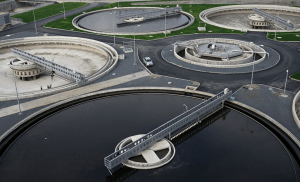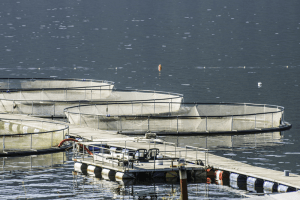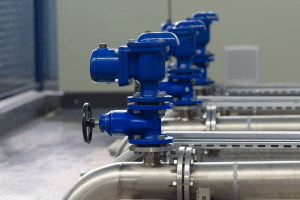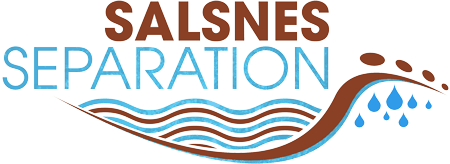Industrial Benefits
 Suspended solids reduction scope and cost
Suspended solids reduction scope and cost
The background to using Salsnes filter is a desire for effective particle separation in order to reduce the scope and costs of the subsequent treatment stage. Factors influencing the choice of solution include restriction on space for water treatment and the customers desire for odour control in the effluent treatment. For industries operating on a 24-hour basis using a SF 2000 machine, a maximum of 300 litres of water is consumed compared to 20,000 litres per 24 hours using competing solutions. With costs of ZAR 5-10 per 1,000 litres of water supplied, and ZAR 10-20 for effluent water, there are considerable benefits. In addition, there are the advantages of properly dewatered sludge, which reduces volume and subsequent costs for sludge treatment.
Raw materials, water and waste effluent The SF machines are easily adapted to other technology in industrial production. It can fit into mid-process, where it might be desirable to recycle raw materials or recycle water. It can also be used at the end of the process for treatment of effluent. Salsnes Filter meets different treatment requirements for Royal Caribbean, Abba seafood, Hunton Fiber, ABB technologies, Heineken beer, or Fjord Halibut AS, but the focus on results is the same. The benefits of small footprint, low water consumption, efficient utilisation of raw materials, odour control and maintenance are considered as a competitive force.
Extended focus on results
Athletes focus on all opportunities in a competitive situation. The same applies to the history of treatment at Hunton Fiber AS in Gjøvik. The company was ordered to reduce effluent to the local river, which ends up in Mjøsa Lake. The technical manager took the opportunity to find a solution to the large waste of raw materials – a problem with which he had been preoccupied for some time. By using Salsnes filter, Hunton Fiber solved both problems, and the investment was recouped after about 12 months. Abba Seafood, Maritex Sortland and Scanship Environmental can tell similar stories.
Best of 300 suppliers
Scanship Environmental AS has specialised in compact total solutions for effluent and waste treatment on board cruise ships. In 2004, they entered into a co-operative agreement with Salsnes Filter to reduce the footprint, size and space requirements for their installations. Using Salsnes Filter’s compact technology, large capacity and high degree of treatment, they are today one of few companies in the world who can meet the US effluent requirements for the coast of Alaska – the most stringent treatment requirements in the world. When Scanship was named Royal Caribbean Cruise line’s best supplier of 300 suppliers in 2005, this was also recognition of Salsnes Filter’s deliveries to this difficult-to-please industry market.
On the biggest cruise ship in the world
 In the spring of 2006, the world’s biggest cruise ship “Freedom of the Seas” was launched. This ship is of the Ultra Voyager type. On board there are two Salsnes filters. The ship can accommodate 4,400 passengers and a crew of 1400, it is 340 metres long, 39 metres wide and there are 18 levels on board with a floor area of about 100,000 m2. The ship was built by Aker Kværner; Masa Yards in Finland.
In the spring of 2006, the world’s biggest cruise ship “Freedom of the Seas” was launched. This ship is of the Ultra Voyager type. On board there are two Salsnes filters. The ship can accommodate 4,400 passengers and a crew of 1400, it is 340 metres long, 39 metres wide and there are 18 levels on board with a floor area of about 100,000 m2. The ship was built by Aker Kværner; Masa Yards in Finland.
We are proud to be part of it.
Fishing and Fish Farming
Modern fish farmers and the fishing industry are at the forefront of competition regarding quality and efficient operation. Their interests overlap in many cases with those of Salsnes Filter, who has developed its treatment technology with a view to deriving benefits in the form of treatment degree, operation and integration, as well as functionality in conjunction with complementary technology.
Beneficial to conditions for growth
Modern fish farmers and the fishing industry are concerned with quality and reduction of operating costs.
 When working with live fish these are two sides of the same coin. Better water environment and conditions for growth influence the quality of the fish and the capacity of the individual fish farm. Better utilisation of feed reduces both running costs and the amount of waste. This gives environmental benefits, which improve efficiency and the status of the product in the market. Specifically, by using conventional drum screens, the problem is that particles are gradually broken down to smaller particles and the smaller particles are not captured by the treatment. By using Salsnes filter the solids will be handled more gently and water quality will be improved.
When working with live fish these are two sides of the same coin. Better water environment and conditions for growth influence the quality of the fish and the capacity of the individual fish farm. Better utilisation of feed reduces both running costs and the amount of waste. This gives environmental benefits, which improve efficiency and the status of the product in the market. Specifically, by using conventional drum screens, the problem is that particles are gradually broken down to smaller particles and the smaller particles are not captured by the treatment. By using Salsnes filter the solids will be handled more gently and water quality will be improved.
Effluent from fish net laundering to sea Another equally demanding challenge lies in the ban on discharging untreated water from fish net laundries to the sea. Salsnes Filter has been working with National Institute of Technology, The Confederation of Norwegian Enterprise (NHO) in Nordland and EPCON Energy & Prosess Controll AS, to develop a total solution for recycling and discharge of effluent that meets the requirements.
When the landfills for sludge depots are gone
Another major challenge for the industry is posed by the sludge produced by some screens. A low concentration of solids due to water hosing of the filters makes dewatering difficult and results in large volumes of sludge. This is both difficult and expensive to get rid of. Normal practice today is to bring the sludge to a different location for dewatering in centrifuges, filter presses or to land fills. However, municipal treatment plants are reluctant to take this sludge, because it complicates the processing of their own sludge. They too have requirements to fulfil and problems to solve because sending sludge to landfill will become illegal in 2009 according to the EU regulations.
Integrated dewatering of sludge
Salsnes filter performs gentle particle separation from the entire water flow, and features integrated technology for thickening and dewatering the sludge. As a separate solution, Salsnes filter also treats sludge water from traditional rotary screen strainers by thickening and dewatering it. The compact technology of Salsnes Filter is very easily adapted to other technology within fish farming and the fishing industry in general.
Enhancing other technologies
In addition to being an active supplier, Salsnes Filter has a proactive attitude to the business’ future challenges. This has resulted in increased activity in cooperation with companies that offer complementary treatment processes. In its land-based recycling facility, Optima Foods Ltd. (Japan) produces the famous poisonous fish Fugu for a discerning restaurant market. Using technology from Salsnes Filter and Aqua Optima, the facility recycles more than 99 per cent of the water. In addition to the economic benefits this has for temperature regulation and water consumption, Optima Food Ltd can also point to 40% faster growth among the fish than other fish farmers. With confidence in the product and positive dialogue with customers and the business, Salsnes Filter will continue to contribute optimum treatment solutions to the fish farming and fishing industries.
Want to learn how Salsnes Filters can transform your separation needs?
Primary Treatment of Municipal Effluent
Salsnes Filter know the Norwegian primary treatment requirements and have the technology to fulfil the task, according to the Norwegian EPA´s reports on primary treatment. This is old news for Hamna treatment facility in Tromsø Municipality , Gammelosen treatment facility in Orkdal Municipality, Mehl treatment facility in Nordfjordeid and Bangsund treatment facility in Namsos Municipality.. Like a lot of other treatment plants, the required treatment is implemented through an organic operational philosophy in which the degree of treatment, economic operation and HSE are all taken into account.
Photo: Havna treatment plant, Tromsø municipality
Salsnes excellence for primary treatment The fact that Salsnes filter is effective and reliable is well documented and does not come as any big surprise. What is however major news is that reports from Norwegian Pollution Control Authority (SFT) confirm Salsnes Filter’s superiority in relation to its competitors. Salsnes Filter is actually the only company that fulfils the primary requirements and technological requirements for primary treatment of municipal effluent.
“The Department of Environment and The Norwegian EPA are behind this programme regarding technology for primary treatment of municipal effluent (2004). One of the goals of the project was to procure more knowledge regarding the treatment principles municipalities should focus on to avoid bad investments and extra costs. The programme is being conducted and led by a committee appointed by THE NORWEGIAN EPA. Some of the results of the projects in the programme are available in SFTs report TA2088/2205 “Primærrensing: Rapport om valg av rensemetode” (Primary treatment: Report on the choice of treatment methods Available in Norwegian only. Summary in English can be provided by contacting Salsnes Filter AS).
Salsnes meet technical requirements
 Salsnes Filter does not just fulfil the primary requirements, it also has the technology to provide the necessary continuity and stable operation. Salsnes filter has endless wire mesh screen and filter mat design and many control options that the report considers important. They apply air flushing, which allows fine mesh cloths, and they remove grease to a certain level in an effective manner without the costly use of too much hot water. Salsnes Filter has the necessary control of cloths with belts and cogwheel, which prevents fine mesh cloths from derailing and getting destroyed. Salsnes Filter has received confirmation of how important it is to invest in research and develop effective and operationally secure technology.
Salsnes Filter does not just fulfil the primary requirements, it also has the technology to provide the necessary continuity and stable operation. Salsnes filter has endless wire mesh screen and filter mat design and many control options that the report considers important. They apply air flushing, which allows fine mesh cloths, and they remove grease to a certain level in an effective manner without the costly use of too much hot water. Salsnes Filter has the necessary control of cloths with belts and cogwheel, which prevents fine mesh cloths from derailing and getting destroyed. Salsnes Filter has received confirmation of how important it is to invest in research and develop effective and operationally secure technology.
An investment in the future
Since THE NORWEGIAN EPA has introduced requirements regarding primary treatment for municipal facilities treating effluent over 10,000 PE, those units that chose treatment solutions based on an overall operational philosophy taking into account environmental benefits and operation can now reap the benefits. This contrasts with those plants that now have to make costly investments in upgrades for primary treatment by December 31, 2008. Not to mention, the new sludge treatment, that Salsnes Filter will deliver if the authorities are serious about banning the sending of sludge to landfill from January 1, 2009.
The most efficient primary treatment plant
The incentive for the most efficient primary treatment plant included in the THE NORWEGIAN EPA report was indeed the high cost of treating wet sludge. Bangsund purification facility, which was a chemical treatment plant, was experiencing high wet sludge treatment costs. With Salsnes Filters input, the sludge has been reduced to about 25% dry solids including chemical sludge. This commission contributed to the development of the new Salsnes Flock, a solution that enables Salsnes Filter to meet the primary treatment requirements at plants where conditions make it very difficult to do so.
Future and operation
Even though Hamna treatment plant in Tromsø comes under the medium-sized category and the Mehl treatment plant in Nordfjordeid must be classified as a small plant, they are both large enough to require primary treatment. Originally Hamna was not required to carry out primary treatment. But now that this requirement is imposed on the plant, the municipality does not have to carry out expensive new construction. Eid municipality built Mehl in Nordfjordeid in accordance with the specifications from the county governor. Due to the location at the end of the long fjord the aquatic environment of the fjord was emphasised and compliance with the EU´s treatment directives was anticipated. The same considerations regarding future requirements and operational considerations applied to Gammelosen treatment plant in Orkdal, which is a relatively large treatment plant. The alternative to primary treatment in that case would have been a conventional chemical treatment plant or biological treatment plant. This solution would have entailed extra costs for sludge thickening and dewatering as well as significantly higher costs for the actual treatment itself. Instead, a simple and non-labour intensive plant was chosen.
Competent customers
Hamna, Mehl, Gammelosen and Bangsund are not unique in prioritising a high degree of treatment efficiency and simple operation. A large number of municipal treatment plants receiving effluent over 10 000 PE have saved their local authorities high costs by making future-oriented investments. Unfortunately, the public is largely unaware of this. At Salsnes Filter, however, our experience is that a good product receives recognition from competent customers.
